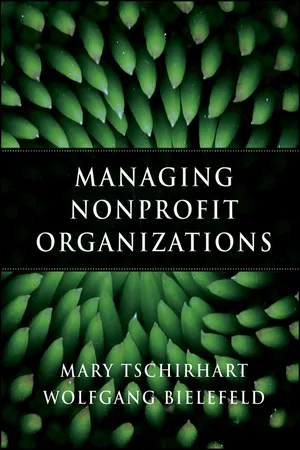
- English
- ePUB (mobile friendly)
- Available on iOS & Android
Managing Nonprofit Organizations
About this book
MANAGING NONPROFIT ORGANIZATIONS
This essential resource offers an overall understanding of nonprofits based on both the academic literature and practitioner experience. It shows how to lead, manage, govern, and structure effective and ethical nonprofit organizations. Managing Nonprofit Organizations reveals what it takes to be entrepreneurial and collaborative, formulate successful strategies, assess performance, manage change, acquire resources, be a responsible financial steward, and design and implement solid marketing and communication plans.
" Managing Nonprofit Organizations is the only introductory text on this subject that manages to do three critical things equally well: It's comprehensive, covering all the key topics leaders of NPOs need to know about; it's practical, providing lots of examples, case incidents, and experiential exercises that connect the content to the real world; and, best of all (and most unique compared to others), it's research-based, drawing on the latest and best empirical studies that look into what works and doesn't work in the world of nonprofit management."
—Vic Murray, professor, School of Public Administration, University of Victoria
"This book is a rarity—a text that can be used both as the focus for academic study and as a source of stimulating ideas for those practitioners who want to explore theories about management and how they can be applied so they can do a better job. Tschirhart and Bielefeld have explained all aspects of nonprofit management and leadership in a way that will stimulate as well as inform."
—Richard Brewster, executive director, National Center on Nonprofit Enterprise, Virginia Tech University
" Managing Nonprofit Organizations presents a comprehensive treatment of this important topic. The book satisfies the competencies and curriculum guidelines developed by NASPAA and by NACC and would be ideal for instruction. The book maintains its commitment to informing management and leadership throughout the nonprofit sector."
—Jeffrey L. Brudney, Albert A. Levin Chair of Urban Studies and Public Service, Cleveland State University
"This is an important book, written by two of the leading scholars in the nonprofit studies field. Nonprofit managers, board members, funders, educators, and others will find Managing Nonprofit Organizations extremely valuable."
—Michael O' Neill, professor of nonprofit management, University of San Francisco
"Here's the book that my students have been asking for—just the right mix of theory presentation, research findings, and practical suggestions to serve the thoughtful nonprofit management practitioner. It will inform, instruct, and ultimately, inspire."
—Rikki Abzug, professor of management, Anisfield School of Business, Ramapo College
Frequently asked questions
- Essential is ideal for learners and professionals who enjoy exploring a wide range of subjects. Access the Essential Library with 800,000+ trusted titles and best-sellers across business, personal growth, and the humanities. Includes unlimited reading time and Standard Read Aloud voice.
- Complete: Perfect for advanced learners and researchers needing full, unrestricted access. Unlock 1.4M+ books across hundreds of subjects, including academic and specialized titles. The Complete Plan also includes advanced features like Premium Read Aloud and Research Assistant.
Please note we cannot support devices running on iOS 13 and Android 7 or earlier. Learn more about using the app.
Information
PART ONE
UNDERSTANDING, ENVISIONING, AND CREATING
CHAPTER ONE
UNDERSTANDING NONPROFIT ORGANIZATIONS
- The history, values, ethics, and philosophies of nonprofit organizations, and the need for transparency in nonprofit management practices to maintain the public trust
- The current legal frameworks for operating a nonprofit organization, and the process of forming an incorporated nonprofit organization
- The fundamental principles and concepts of fiscal management, revenue generation, and fundraising, and the ethical imperative to be a good steward of the financial resources of the nonprofit sector
- The leadership challenges of the sector as they relate to the strategic management of nonprofit organizations, which requires integrating the roles, responsibilities, and relationships of the board of directors, the executive director, the employees, the volunteers, and all stakeholders in meeting the mission of the organization
- The human resource and volunteer management principles necessary to manage a nonprofit organization’s core services and functions
- The standards for accountability, performance measurement, and program evaluation, and the appropriate techniques for using both quantitative and qualitative methods to measure the performance of nonprofit organizations
A Roadmap Through the Chapters
Table of contents
- Cover
- Table of Contents
- Title
- Copyright
- Acknowledgments
- The Authors
- Part One: Understanding, Envisioning, and Creating
- Part Two: Strategizing, Resourcing, and Aligning
- Part Three: Leading, Managing, and Delivering
- Part Four: Evaluating, Connecting, and Adapting
- Appendix
- Index
- End User License Agreement